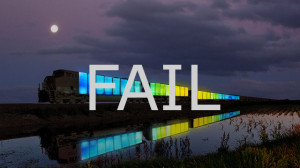Station to Station, in Oakland at least, appeared guilty of the same party foul and the lack of transparency around Levi’s motives somehow makes them more vile than the art fairs. The art fairs are candid in what they want to do: they are there to sell. But what is Levi’s investment in the arts about exactly? Why the sudden interest in public art and entertainment? The answers became clearer as the night wore on, but the initial scene in Oakland was a snapshot of everything that is wrong in the Bay Area right now: big money comes in and, for entertainment, co-opts the creative class while it displaces longstanding communities.
After walking several blocks past the event to get in line, only to then shuffle back over the same broken ground to make my way to the entrance, I was shunted through security. A smiling young man affixed a sticker to my lapel and hastily greeted me. “Here is tonight’s hashtag!,” he announced cheerily, before making me into a walking, talking advertisement for Levi’s social media feed. It was creepy and I stuck my sticker on his denim-clad back as I walked away. (Before getting her sticker, professional photographer Deborah Svoboda, on site to take images for KQED Arts with thousands of dollars worth of professional equipment, was joyously told “You look like an Instagrammer!”)

Just beyond the entrance, a sign was posted high in the air, deliberately situated to avoid catching anyone’s attention. It read: “CROWD NOTICE RELEASE. PLEASE BE AWARE THAT, BY ENTERING THIS AREA, YOU CONSENT TO YOUR VOICE AND LIKENESS BEING USED WITHOUT COMPENSATION IN FILMS AND TAPES FOR EXPLOITATION IN ANY AND ALL MEDIA, WHETHER NOW KNOWN OR HEREAFTER DEVISED, AND YOU RELEASE STATION TO STATION LLC, AND ITS SUCCESSORS, ASSIGNS, AND LICENSEES FROM ANY LIABILITY ON ACCOUNT OF SUCH USAGE. IF YOU DO NOT WISH TO BE SUBJECT TO THE FOREGOING, DO NOT ENTER THIS AREA.” This sign solidified my dawning realization of Levi’s motivations with the project, which had nothing to do with aligning with the avant-garde or supporting art. It was a way to create marketing materials in perpetuity. The event, from station to station, as it were, was designed to capture as much documentation of the creative class at play as possible and to use it in “lifestyle” campaigns to promote Levi’s. Whether or not participants were wearing the brand mattered little because so many people wear denim by default and it all looks the same at a distance, doesn’t it? So, having paid for the privilege of being exploited, I was ready to leave, but stayed with the hope that the art would somehow make it worthwhile.
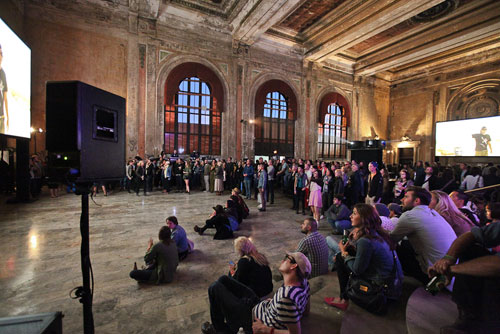
Many who attended were excited to see Oakland’s historic train depot in person. For a lot of people this condemned historic landmark is compelling for its architectural beauty, its lost history, and its more radical iteration now as a magnet for graffiti. But it was shockingly unconsidered as a site for contemporary art. There were no site-specific works that engaged the building or drew on its history. The main station hall was employed as a big viewing area to watch barely audible Doug Aitken’s interviews with “participating” artists. This offered another egregious revelation: much of the roster of “participatants,” so compelling on the website, was essentially a playlist of prerecorded video interviews. Promising, or alluding to promising, the involvement of amazing artists and then offering up videos that just as easily could be watched online was a lame bait and switch.
A poster-cum-artwork wheat pasted onto the entrance of the historic station read “You are on Indian land. Show some respect.” The sheer irony that the organizers might have placed this work there while overtly disregarding the history of the site itself and the surrounding community was mindboggling. So too was this example of how politically potent work could be co-opted by commerce for the sake of making a “cool” statement. It was the most provocative work of the evening, though I was never sure if it was part of the show or there prior.
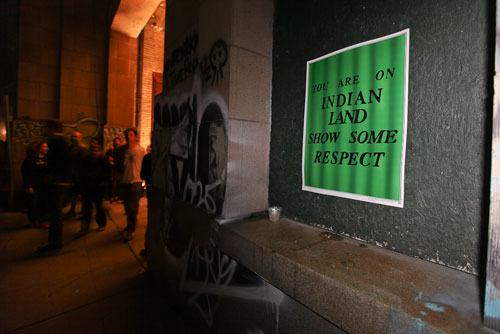
Somehow I thought we would see real large-scale commissions in the station, on par with Aitken’s architectural video installations or a giant Ernesto Neto taking over the whole space. It was a waste of such rarified space. All I could think of when I saw the station’s interior were the many artists who could have done so much more with the building. When I expressed my disgust over this lack of thought about the site, a colleague said, “Well, the projects have to be simple so that they can be shown from one stop to the next.” But that isn’t an organizational principle of public art — one size fits everywhere — and there was nothing that said that it had to be considered that way at all. The millions spent on this giant ad campaign could have enabled some artists to make real work and the whole endeavor might have retained some integrity. To add further insult to injury, the New York Times reported that none of the participating artists were paid.
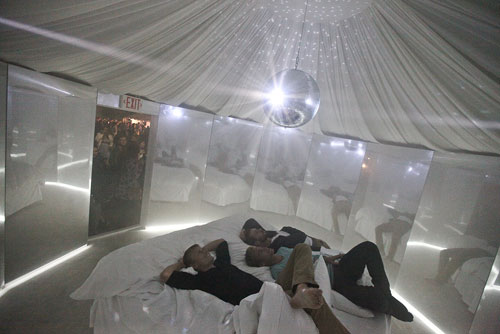
All night I heard people asking, “Where is the art?” What little art on display was presented in a cluster of four pop-up yurts that looked as time-worn as circus tents. I stood in line for forty minutes to see Urs Fischer’s all-white installation, now dingy from travel, featuring a white carpet, a white bed, mirrored walls, a disco ball and a fog machine. The line of people on the other side of the door made it feel tawdry and awkward. There was also an unlabeled photo exhibit of five or six mysterious images in a breezeway next the station’s main room, but their textural quality was no match for the patina of the walls on which they hung. They looked small and insignificant, as did all of the art, what little there was, on display.
There was no didactic information to speak of: no signs denoting the names of artists or artworks, or a schedule of screenings or performances. Lines for everything from the installations to the scant two food trucks were dismally long. I constantly overheard people saying “What are we in line for?”
The “print media” alluded to in the press materials essentially amounted to a pop-up bookstore selling monographs by each of the “participants” — and not actually distributing artist-designed posters or postcards as one might have hoped. What kind of billing is this? A list of artists whose books are for sale is not a list of “participants;” it is a list of merchandise. This slippery use of language denotes a lot of time spent thinking about how to excite people without delivering anything of substance. The constant hype to sell to the viewer while exploiting the viewer was so transparent as to be cliché. I saw boxes of event posters behind a desk, but they weren’t out for the taking. By the time I saw them, I would rather have been handed a rattle snake.
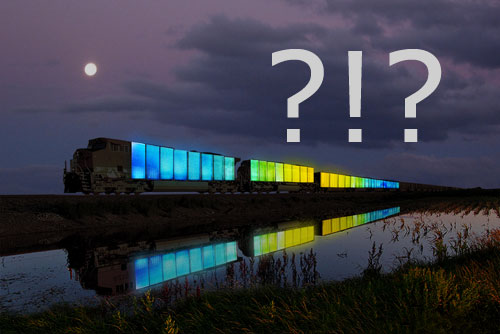
Most galling, there was no sign of the Doug Aitkin train that had been touted in the marketing materials as a public art video installation in motion. The train promised a huge spectacle — and we came for spectacle. It’s a historic station and this whole epic derail is called “Station to Station,” for crying out loud. And yet still, the train was nowhere near the historic station on the night of the event. It was parked at Amtrak across town.
After informally polling Facebook friends across the country about other stops, I have yet to encounter anyone who actually saw the train as it was portrayed in the hyped-up marketing, and the consensus has been that the public events were underwhelming all along the way. It should have been infuriating that there was no train, but people were too dazed to reconcile what they thought they were getting with what they got.
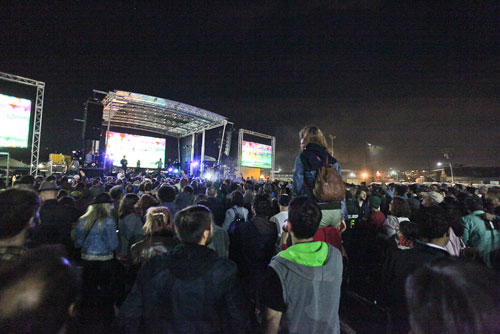
I could go on, but I won’t, about the “makers” who were corralled in an open air sweatshop, I mean tent, toiling over handmade wares beneath naked light bulbs swinging overhead, or about the strangeness of Levi’s vague branding of the event as a fundraiser for SFMOMA (the event was in Oakland — so why not benefit an Oakland arts organization?) or the strange videos on the music stage that altered between “road trip” scenery and what looked like Christian Marclay footage, blurring the line between ads and actual art — or what looked like art because someone ripped off an artist to make animated backdrops. The music performances might have been redemptive — I heard from many that they were “OK” — but having come with the expectation of seeing great work, I barely noticed the music, which was clearly planned to be more ambient than a real concert. Any louder and it would have interfered with capturing audio for the marketing materials of the future.
As there are no laws about truth in advertising — wait, are there? — everyone in attendance will be complicit in the perceived “success” of this dud. Station to Station promised great artists and great art — a train tricked out with video screens dashing across the country — and instead we got some third rate Burning Man rip-off abbreviated rock show with smoke and mirrors, no art, no train, and everything but our DNA stripped at the door. Based on Levi’s self-satisfaction, more brands will follow suit in making contemporary art into a carnival road show; that train has apparently already left the station. Welcome to the modern frontier — privacy is a thing of the past, corporations control culture, and there is no art to be seen.

